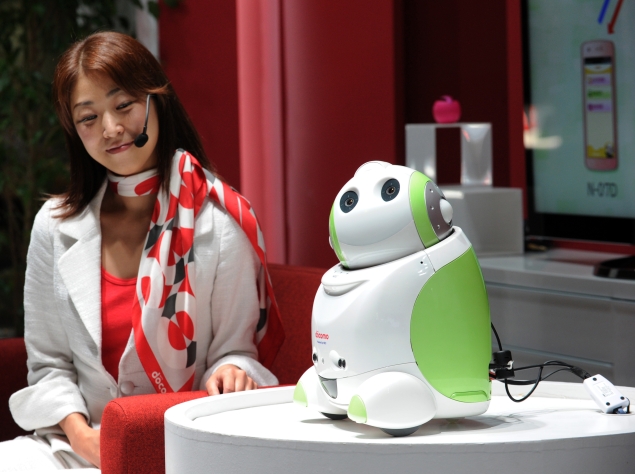- Home
- Science
- Science News
- Researchers develop robot with better people skills
Researchers develop robot with better people skills

Researchers are programming robots to communicate with people using human-like body language and cues.
Researchers at the University of British Columbia enlisted the help of a human-friendly robot named Charlie to study the simple task of handing an object to a person.
"We hand things to other people multiple times a day and we do it seamlessly," said AJung Moon, a PhD student in the university's department of mechanical engineering.
"Getting this to work between a robot and a person is really important if we want robots to be helpful in fetching us things in our homes or at work."
Past research has shown that people have difficulty figuring out when to reach out and take an object from a robot because robots fail to provide appropriate nonverbal cues.
AJung and her colleagues studied what people do with their heads, necks and eyes when they hand water bottles to one another.
They then tested three variations of this interaction with Charlie and the 102 study participants.
Programming the robot to use eye gaze as a nonverbal cue made the handover more fluid.
Researchers found that people reached out to take the water bottle sooner in scenarios where the robot moved its head to look at the area where it would hand over the water bottle or looked to the handover location and then up at the person to make eye contact.
"We want the robot to communicate using the cues that people already recognise," said AJung. "This is key to interacting with a robot in a safe and friendly manner."
The paper based on the work was declared the best paper at this year's International Conference on Human-Robot Interaction held in in Bielefeld, Germany.
Get your daily dose of tech news, reviews, and insights, in under 80 characters on Gadgets 360 Turbo. Connect with fellow tech lovers on our Forum. Follow us on X, Facebook, WhatsApp, Threads and Google News for instant updates. Catch all the action on our YouTube channel.
Related Stories
- Samsung Galaxy Unpacked 2025
- ChatGPT
- Redmi Note 14 Pro+
- iPhone 16
- Apple Vision Pro
- Oneplus 12
- OnePlus Nord CE 3 Lite 5G
- iPhone 13
- Xiaomi 14 Pro
- Oppo Find N3
- Tecno Spark Go (2023)
- Realme V30
- Best Phones Under 25000
- Samsung Galaxy S24 Series
- Cryptocurrency
- iQoo 12
- Samsung Galaxy S24 Ultra
- Giottus
- Samsung Galaxy Z Flip 5
- Apple 'Scary Fast'
- Housefull 5
- GoPro Hero 12 Black Review
- Invincible Season 2
- JioGlass
- HD Ready TV
- Laptop Under 50000
- Smartwatch Under 10000
- Latest Mobile Phones
- Compare Phones
- Realme P4x 5G
- OnePlus Ace 6T
- OPPO A6x 5G
- Samsung Galaxy Z TriFold
- Poco F8 Ultra
- Poco F8 Pro
- Huawei Mate 80 RS Master Edition
- Huawei Mate 80 Pro Max
- Asus ProArt P16
- MacBook Pro 14-inch (M5, 2025)
- Poco Pad M1
- Poco Pad X1
- Just Corseca Skywatch Pro
- Honor Watch X5
- Acerpure Nitro Z Series 100-inch QLED TV
- Samsung 43 Inch LED Ultra HD (4K) Smart TV (UA43UE81AFULXL)
- Asus ROG Ally
- Nintendo Switch Lite
- Haier 1.6 Ton 5 Star Inverter Split AC (HSU19G-MZAID5BN-INV)
- Haier 1.6 Ton 5 Star Inverter Split AC (HSU19G-MZAIM5BN-INV)

















